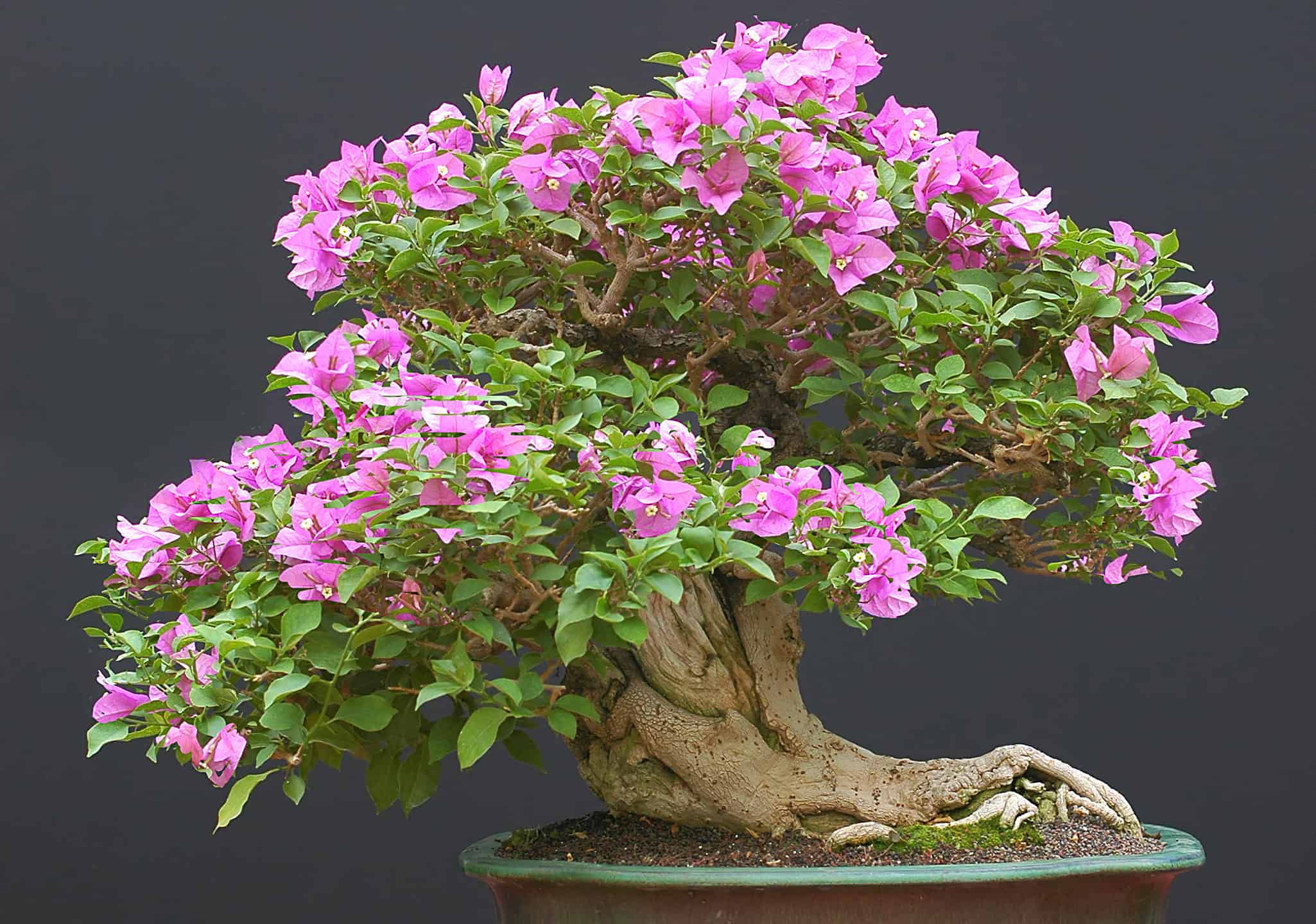The art of bonsai is one of the most rewarding, “advanced” actions in the gardening world. There are numerous varieties that serve well as both indoor and outdoor species, many of which are vibrantly floral, lusciously fruity, or particularly useful in other ways. They add beauty and intrigue to any space as well, but even more importantly, they provide a rich spiritual practice anyone from any background can appreciate.
The Zen art of bonsai has flourished around the world for many years, with many species, and among those beautiful plants is the multi-colored bougainvillea.
Learn all about this stunning flowering bonsai and see if it might be the right choice for your Zen hobby, keeping in mind the many beautiful colors and shades to choose from, adding an extra layer to your personalization.

Notice the veined, paper-thin blooms overtaking the tree. Stunning color like this is what draws most to the plant for bonsai.
©Walter Pall/Shutterstock.com
What Makes a Bougainvillea Good for Bonsai?
Bougainvillea are one of the best options for bonsai enthusiasts for multiple reasons, one of the main ones being they do well as both indoor and outdoor bonsai trees. You will have to take special care and provide for its needs, of course, but that’s the joy of bonsai gardening.
The plant offers blooms in numerous colors, ranging from the common fuchsia flower to the rich orange-gold shades less commonly.
Admittedly, they are not the easiest to care for, but that’s mainly because of winter temperature controls. If you access to cool greenhouse or a space in which you can keep the temperature cool and precise during winter months, the bougainvillea bonsai is otherwise fairly easy to care for with some forethought and effort.
Bougainvillea Classification
The bougainvillea has numerous cultivars and varieties, but the most common for bonsai use is the Bougainvillea glabra. The plant is part of the Nyctaginaceae family and is a seasonal bloomer.
Bougainvillea Description
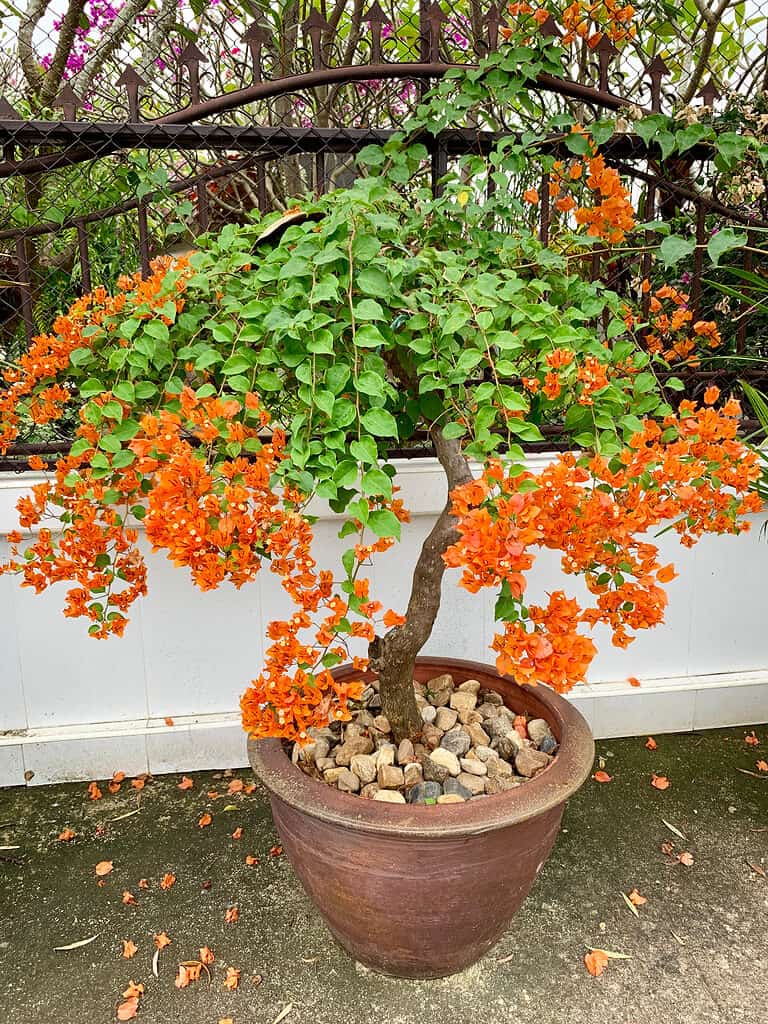
Bougainvillea come in many colors and work in many planting shapes.
©Chaipruck Mekara/Shutterstock.com
The bougainvillea is a flowering woody shrub or vine that produces unique, papery flowers that come in a variety of colors. The most common shades you’ll find include fuchsia, pink, orange, red, yellow, white, purple, and even some bi-color varieties. The flowers are terminal or axillary tufts that show up in summer through autumn, depending on species and location, with a paper-thin texture that resembles leaves more closely than common flower petals like those on roses or gardenias.
The leaves are oval to lanceolate, in an alternate pattern, while the bark is beige to gray. As the plant ages, the bark becomes gnarly and furrowed. The plant, when left to natural growth patterns, may reach as tall as 40 feet, qualifying it as a small tree.
Origins and History of Bougainvillea
Bougainvillea gives off a tropical island vibe – and there’s good reason for that. There’s some debate as to when and where the plant was actually discovered, but it believed to be French naturalist and botanist Dr. Philibert Commerçon. Some folks believe it was discovered on the coast of Brazil, near Rio de Janeiro in 1768, while others believe it was Tahiti in 1767. Either way, the plant was named for the French ship captain (La Boudeuse) and author, Louis-Antoine de Bougainville. The ship he captained sailed around the world from 1766 to 1769, which is probably where most of the confusion on timing and location comes in. The plant natively grows in these two locations as well as Argentina, and Peru.
Varieties of Bougainvillea
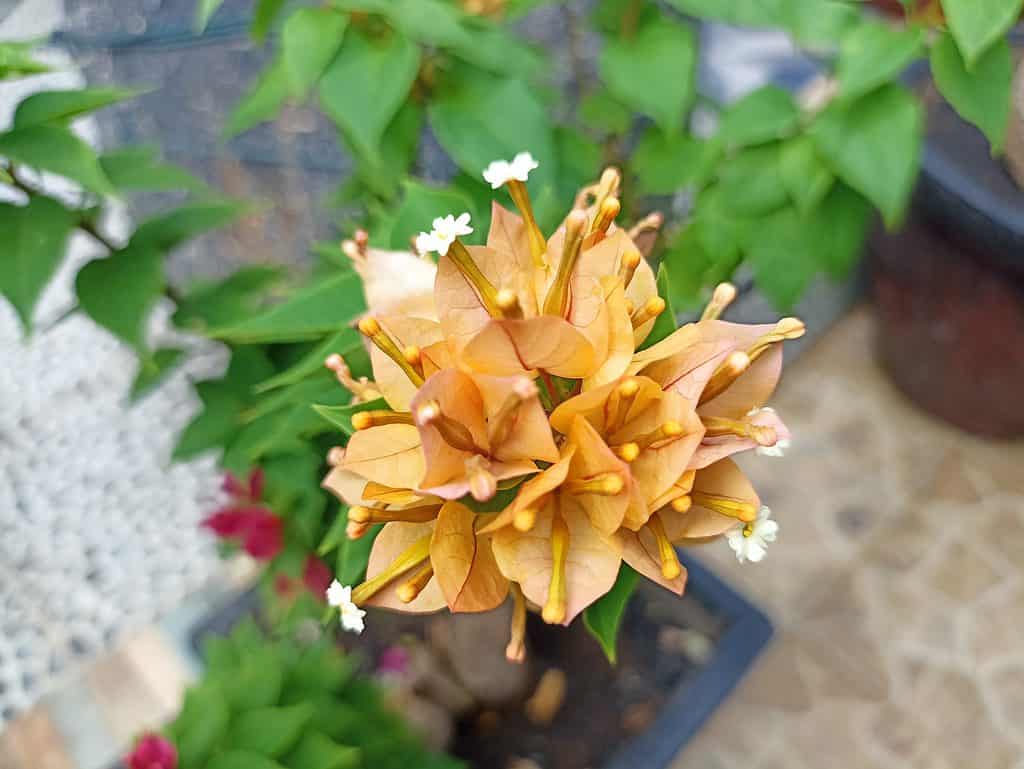
The flowering plant comes in many varieties which work wonderfully as potted plants and bonsai.
©Martina Sappe/Shutterstock.com
There are several varieties of the Bougainvillea glabra that are used commonly in the bonsai art form. You will also find some Bougainvillea peruviana and Bougainvillea spectiabillis, as well. The plant has been highly hybridized, though, so ultimately, you’ll find more varieties than you could ever consider.
Some of the most popular varieties include:
- Hawaiian gold
- Orange queen
- Raspberry ice
- Bambino Zuki
- Bambino Pedro
- Bambino Zulu
- Bambino Zeffa
- Bambino Panda
- Bambino Jalibene
The Bambino varieties have fewer thorns, are more compact, and grow shorter, which makes these varieties particularly popular among bonsai growers.
Care Guide for Bougainvillea Bonsai
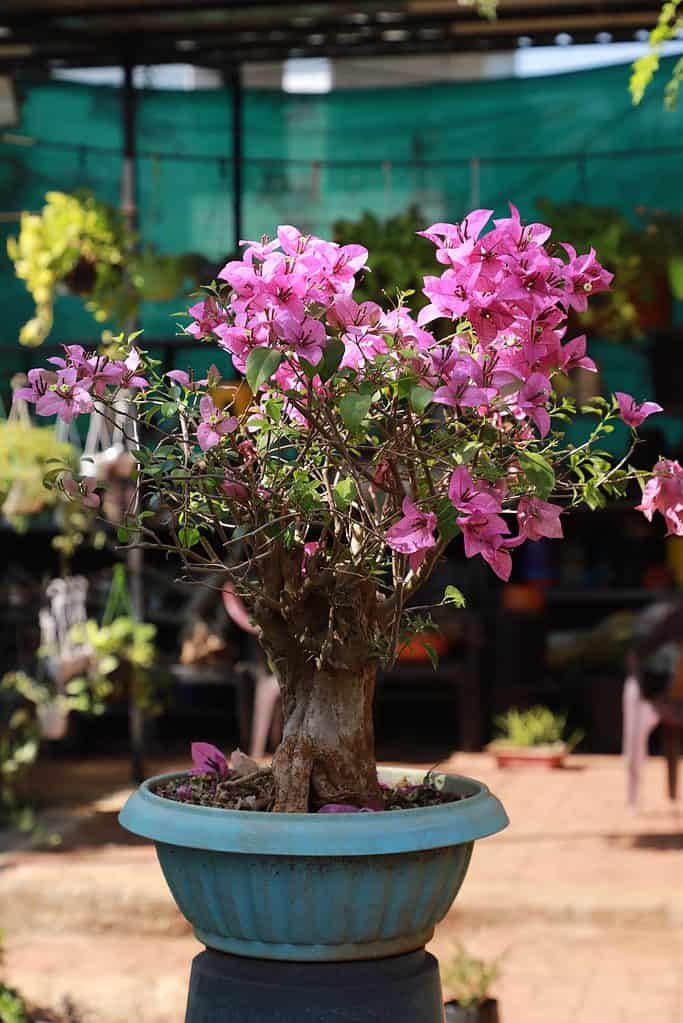
Fuchsia, pink, and purple are the most common colors found in bougainvillea.
©Rtraxphoto/Shutterstock.com
Soil Needs
Bougainvillea bonsai require loads of nitrogen in their soil to produce those stunning, colored leafy blooms. They also require organic material in the soil (40%), and do well with a combination of agricultural pumice, decomposed granite, coarse sand, or some combination thereof.
Planting Location
One of the reason many folks love bougainvillea is because they are fast growers. They tolerate a lot of care (like pruning), as well, which makes them excellent for most bonsai styles. But the key is placement for these flowers. They’re subtropical, meaning they don’t handle cold weather and frost, and they need full sun to thrive.
They can tolerate both indoor and outdoor planting, but let’s be honest – they thrive when grown outdoors in warm enough weather.
For outdoor placement, make sure they’re in sunny locations during the growing season. For cooler months, they need to be brought indoors and cared for properly with loads of light (read: grow lights!) in south-facing windows.
Lighting
Bougainvillea are lovers of light. Give them plenty of direct sunshine both indoors and outdoors, additionally offering grow lights if the bonsai is kept indoors. They need at least 6 hours of light every day.
Temperature
Being subtropical plants, bougainvillea need warm temperatures to grow. They do not survive in temperatures consistently under 40 degrees F in their dormant season and should not be taken outdoors until overnight temperatures are at least 50 degrees F consistently. They do not handle frost at all. Ideal indoor temperatures in winter (dormancy) should be between 50- and 55-degrees F, which is challenging to maintain in most households. This is probably the main reason they’re not considered an “easy” beginner bonsai.
Watering
Whenever the soil gets dry, your bougainvillea needs a thorough watering. You should let the soil get a little bit dry, actually, to prevent the plant from having root rot and fungal growth.
You also want to use rainwater, distilled water, or highly filtered noncalcareous water, with pH levels between 6 and 6.5.
Feeding
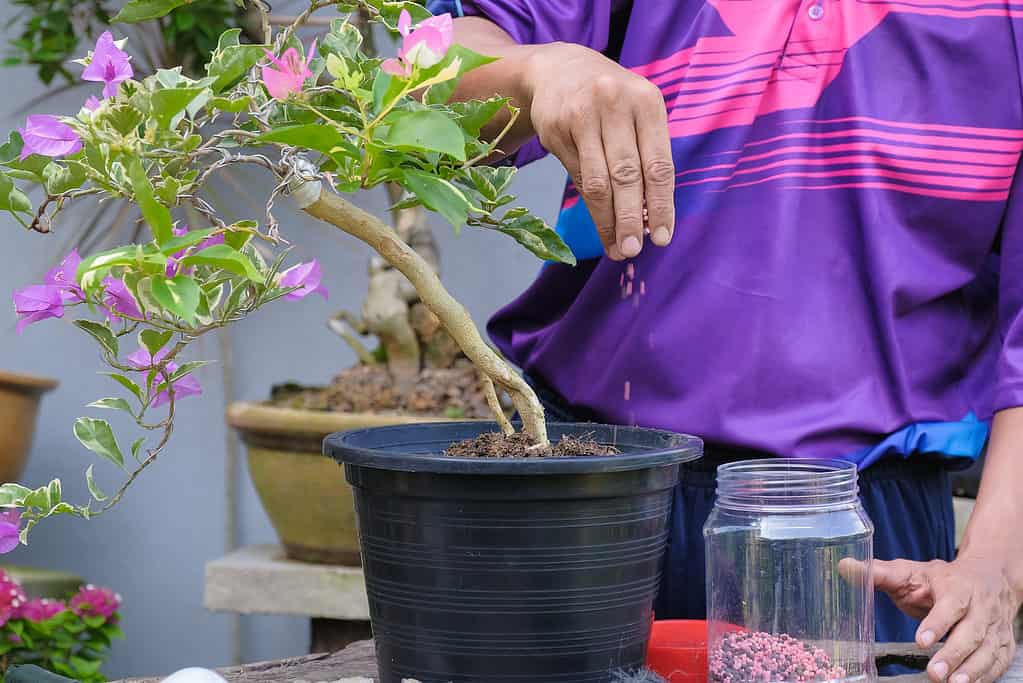
Use solid or liquid fertilizer that’s high in nitrogen for best results.
©Azami Adiputera/Shutterstock.com
Bougainvillea do best with solid organic fertilizer pellets every month from spring to autumn, or liquid fertilizer every week during growing season and twice a month in wintertime. They do best with specific bonsai fertilizers that are slow release with nitrogen, potassium, and phosphorous in equal ratios. This is known as a N-P-K fertilizer.
Pruning, Shaping & Wiring

Bougainvillea bonsai must be pruned and shaped in the right season to ensure healthy growth and flowering.
©Azami Adiputera/Shutterstock.com
A quick reminder before you consider shaping your bougainvillea: the plant has thorns! It’s recommended that you wear gloves when working with bougainvillea to avoid injury.
When you’re ready to style your bougainvillea, you’ll want to cut the shoots after flowering has ended. Leave behind two leaves on each shoot and prune the twigs and branches in the autumn or winter, ideally, to encourage growth in the right seasons. You may notice some buds developing from hard pruning on old wood.
Additional tips:
- If you want heavier flowering, avoid pinching and trimming in summer, when possible.
- Be sure to use cut paste on larger wounds when trimming and pruning. This will help the tree heal more quickly.
- Only attempt to wire young shoots and twigs; older branches are brittle and may break or otherwise sustain damage.
- Do some pruning each month of the growing season, but don’t go crazy.
Re-potting
Every two to three years, you will need to re-pot your bougainvillea bonsai. Once the plant becomes larger, it will need re-potting every four or five years.
The roots of the bougainvillea tend to be rather thing and delicate. It’s important that you treat them with great care at every stage of the re-potting process. Do not use a root rake to untangle the roots, unless you’re able to do so very gently. Otherwise, use your fingers.
Clean out the old potting medium thoroughly, both from the roots and the pot, and then place the root ball gently into the pot. Fill in the medium around the root ball, ensuring there is nothing blocking the drainage holes. The plant is particularly susceptible to root rot, so this step is critical.
Other re-potting tips:
- Re-potting is best done in warmer months.
- Even if the prescribed time hasn’t passed, if you notice roots beginning to come out of the drainage holes, it is time to re-pot.
Common Problems of Bougainvillea

The sturdy trunk shows the age of the bougainvillea.
©Evgeniya Uvarova/Shutterstock.com
Thankfully, bougainvillea tends to be a pest-resistant species when it is properly cared for. They do need enough light and the right water to dryness balance in their care, otherwise things like powdery mildew and root rot may arise. Additionally, mealy bugs, white flies, aphids, caterpillars, or scale may appear. But gentle, nontoxic, organic pesticides and fungicides take care of them. Be sure to check roots for rot if you notice flowers wilting or dropping. Cut these off and trim the bad roots, if possible, to spare the tree.
How to Propagate Bougainvillea
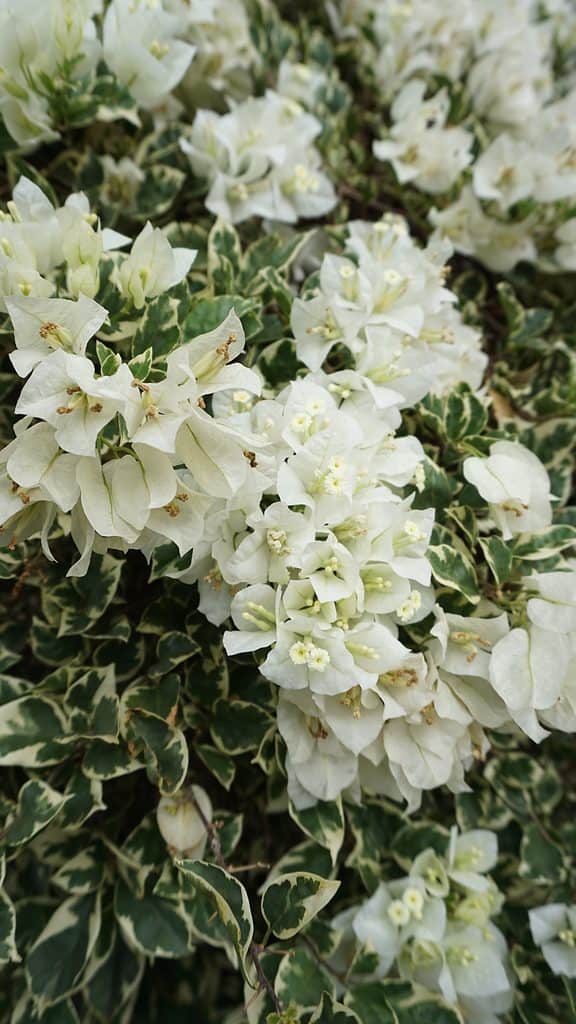
The unique, beautiful flowers come in many colors, including vivid white.
©Ririn Rinawati/Shutterstock.com
Generally speaking, the best method for propagating your bougainvillea bonsai is through cuttings. It’s not terribly difficult to do this, thankfully.
- Lightly dampen some potting soil and fill a small container with the soil and rooting hormone.
- Trim your bougainvillea branches from the mother plant, making sure no leaves are at the base of the cuttings.
- Clip away any leaves from the bottom of the cutting.
- Now, dip the cut ends into rooting hormone and then place into the prepared container with soil and hormone.
- Place the cuttings into a greenhouse, grow tent, or somewhere similar, where the plants will be protected, kept warm, and provided with some humidity.
- Make sure the soil is kept moist but never gets soggy.
- Provide the cuttings with plenty of light through grow lights (ideally LED grow lights with full spectrum).
- When the plants have rooted, re-pot them into larger containers – ideally the bonsai pots – and care for properly as directed above for bougainvillea bonsai.
Bougainvillea Bonsai FAQs

Bougainvillea come in many shades, with those vibrant reds, pinks, and purples most common.
©Martina Sappe/Shutterstock.com
If you still have some questions about bougainvillea bonsai, these FAQs might hit the spot.
How long does a bougainvillea bonsai take to grow?
Bougainvillea are fast growers. They often grow as much as three feet in a single year, when left “wild” and natural to grow as a standard plant. As bonsai, they are slower growing, if trimmed properly, though. In the first year, you may find the urge to let the plant grow wild, which isn’t inherently wrong. Let it grow but keep proper care of it and help it not to outgrow the bonsai pot it is in or it will potentially have issues later on.
How long do bougainvillea live?
If properly cared for, with enough sunlight, proper watering schedule, and warm enough temperatures in its growing space, a bougainvillea bonsai may have a long, many-year life. They may live up to 40 years, even, when cared for in ideal conditions.
How do I care for bougainvillea bonsai in winter?
Bougainvillea are warm-weather only plants. This means you will need to ensure the plant is well-cared for in winter. You should rarely feed the plant in winter, it must be kept in warm temperatures, though ideally “cool” for tropical climates (i.e., 50- to 55-degrees F), with enough water and light to keep it healthy without encouraging non-seasonal growth. You should ensure the plant is sheltered from wind and cold temperatures if outdoors, and drafts and air vents it kept indoors. Cut back on watering the plant in winter, as well, again to help avoid the growth issues that may come and potentially harm your plant’s natural rhythms.
Why are the leaves and flowers dropping?
During winter months, it’s quite likely your bougainvillea will drop both leaves and flowers. This is quite natural. However, if it’s happening a lot, you need to change the conditions in which the bonsai is growing. Check the temperature. Is it warm enough? Is the tree getting enough light?
In non-winter months, or bonsai trees near grills, ask these questions:
- Has the bonsai been near the grill when its on? Could it have been exposed to ethylene gas?
- Has the bonsai been placed near a poolside? The chlorine could be messing with the plant.
- Is the plant receiving too much water? Check the roots. Is the soil soggy? Are the roots mushy?
How do I encourage blooming in my bougainvillea?
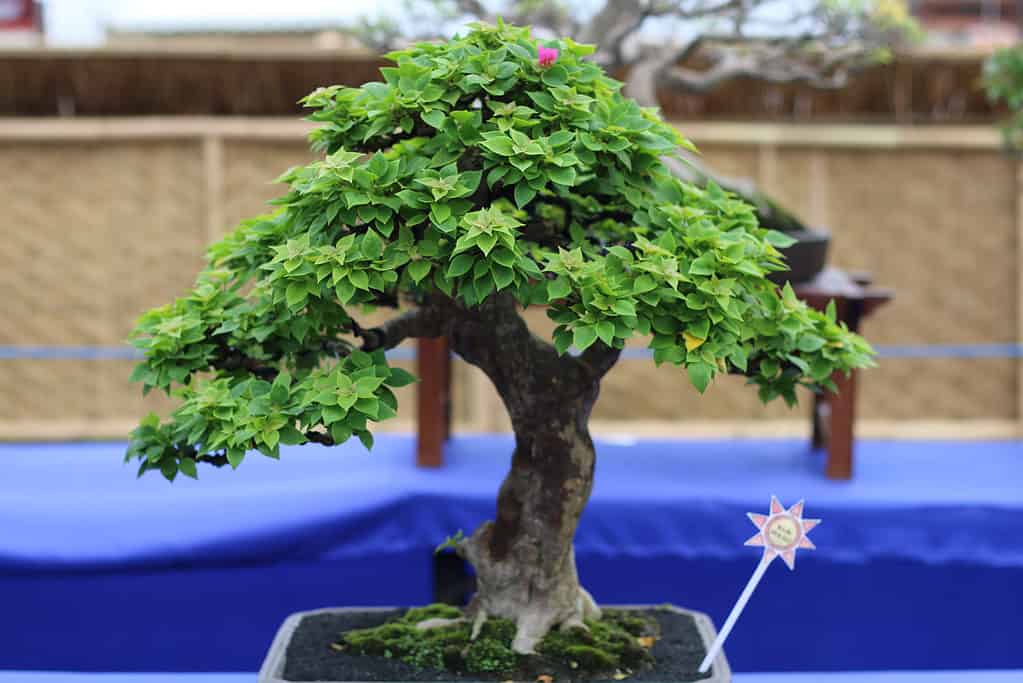
Sometimes, bougainvillea need a little break from feedings, watering, or other things to encourage that blooming again.
©Arya Gunadi/Shutterstock.com
If you find your bougainvillea isn’t producing many flowers but it’s not got problems like root rot or cold temperatures going on, you may actually find you need to ease off on the attention a little bit. Initially, cut back on watering a little bit (nothing crazy – don’t dry it out completely!) and see if that helps. If that doesn’t, check the sunlight. Is it actually getting 6 or more hours of direct light per day? Finally, skip a cycle of fertilizer or try a lower nitrogen fertilizer for a little while and see if this resolves the issue.
Up Next:
Thank you for reading! Have some feedback for us? Contact the AZ Animals editorial team.

